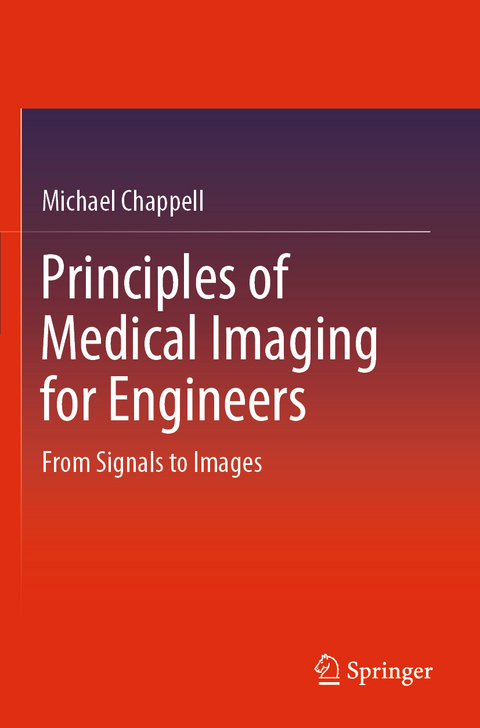
Principles of Medical Imaging for Engineers
Springer International Publishing (Verlag)
978-3-030-30513-0 (ISBN)
This introduction to medical imaging introduces all of the major medical imaging techniques in wide use in both medical practice and medical research, including Computed Tomography, Ultrasound, Positron Emission Tomography, Single Photon Emission Tomography and Magnetic Resonance Imaging. Principles of Medical Imaging for Engineers introduces fundamental concepts related to why we image and what we are seeking to achieve to get good images, such as the meaning of 'contrast' in the context of medical imaging. This introductory text separates the principles by which 'signals' are generated and the subsequent 'reconstruction' processes, to help illustrate that these are separate concepts and also highlight areas in which apparently different medical imaging methods share common theoretical principles. Exercises are provided in every chapter, so the student reader can test their knowledge and check against worked solutions and examples.
The text considers firstly the underlying physical principles by which information about tissues within the body can be extracted in the form of signals, considering the major principles used: transmission, reflection, emission and resonance. Then, it goes on to explain how these signals can be converted into images, i.e., full 3D volumes, where appropriate showing how common methods of 'reconstruction' are shared by some imaging methods despite relying on different physics to generate the 'signals'. Finally, it examines how medical imaging can be used to generate more than just pictures, but genuine quantitative measurements, and increasingly measurements of physiological processes, at every point within the 3D volume by methods such as the use of tracers and advanced dynamic acquisitions.
Principles of Medical Imaging for Engineers will be of use to engineering and physical science students and graduate students with an interest in biomedical engineering, and to their lecturers.
lt;p>Michael Chappell is an Associate Professor of Engineering Science at the Institute of Biomedical Engineering (IBME), Department of Engineering Science, University of Oxford. He is the Director of Training for the EPSRC-MRC Centre for Doctoral Training in Biomedical Imaging. Michael heads the Quantitative Biomedical Inference group that brings together inference techniques from information engineering with mathematical models of physics and physiology to estimate quantitative information for biomedical and especially clinical applications. His main interest is in medical imaging of metabolism and haemodynamics. Michael read Engineering Science in Oxford at undergraduate level, specializing in information engineering topics and completing a project on the detection of landmines. He stayed to complete a doctorate in SCUBA diving, primarily using mathematical models to explore the growth of bubbles from dissolved gases under decompression in the body - the resulting sickness is commonly referred to as 'the bends'. Finally he found his way into Magnetic Resonance Imaging and now develops ways to measure blood flow and pH in the body with applications in stroke, cancer and dementia. Michael is the co-author of Physiology for Engineers and is a series editor for the Oxford Neuroimaging Primers and an author of two of the primers, Introduction to Neuroimaging Analysis and Introduction to Perfusion Quantification using Arterial Spin Labelling.
What is Medical Imaging?.- Part I: From Signals....- Basic Concepts.- Transmission: X-Rays.- Reflection : Ultrasound.- Emission: SPECT/PET.- Resonance: NMR.- Part II: ...To Images.- A Revision of Frequency Analysis.- Basic Concepts.- Timing-Based Reconstruction.- Back-Projection Reconstruction: X-Ray and PET/SPECT.- Fourier Reconstruction: MRI.- Part III: Functional and Physiological Imaging.- Contrast Agents.- Tracer Kinetics.- Examples of Tracer Kinetic Methods.- Other Physiological and Functional MRI Methods.
"The well-illustrated book is written in simple language that is suitable for either an introductory course or for self-study. The math and physics prerequisites are rather minimal and well within the skill set of a typical undergraduate sophomore- or junior-level engineering student. ... If I were to teach an introductory semester-long course in medical imaging, this book would be my primary choice." (Vengu Lakshminarayanan, Optics & Photonics News, osa-opn.org, August 13, 2020)
| Erscheinungsdatum | 18.10.2020 |
|---|---|
| Zusatzinfo | XIV, 169 p. 64 illus., 33 illus. in color. |
| Verlagsort | Cham |
| Sprache | englisch |
| Maße | 155 x 235 mm |
| Gewicht | 290 g |
| Themenwelt | Medizin / Pharmazie ► Physiotherapie / Ergotherapie ► Orthopädie |
| Naturwissenschaften ► Biologie ► Genetik / Molekularbiologie | |
| Technik ► Umwelttechnik / Biotechnologie | |
| Schlagworte | Computed tomography • Magnetic Resonance Imaging • Medical Imaging • Nuclear Medicine • Positron Emission Tomography • Single Photon Emission Tomography • Ultrasound • X-Ray |
| ISBN-10 | 3-030-30513-9 / 3030305139 |
| ISBN-13 | 978-3-030-30513-0 / 9783030305130 |
| Zustand | Neuware |
| Haben Sie eine Frage zum Produkt? |
aus dem Bereich


